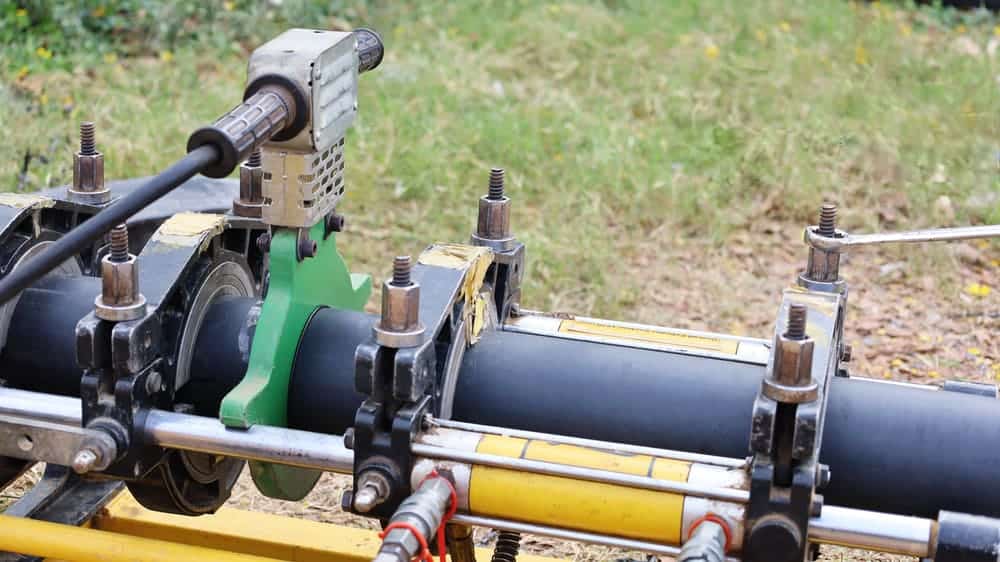TOFD Inspection of HDPE Piping for Petrochemical Use

High-density polyethylene (HDPE) is a common material used to create pipes in the petrochemical industry. The material is often preferred because of its chemical- and corrosion-resistant properties. Because HDPE pipes are used to transport crude oil, water, and slurries, safety and reliability are critical. The nature of the fluids that HDPE pipes carry has made it imperative for asset owners to thoroughly inspect the quality of the piping system.
Heat and pressure are used to weld HDPE pipe joints. To detect any flaws and impurities that may occur as a result of welding processes like HDPE welding, industries have historically relied on ultrasonic technology for inspection. However, with HDPE it is very difficult to generate acoustic sound beams with appropriate refracted angles. The material is highly attenuative. Therefore, lower inspection frequencies will typically be used compared to carbon steel. So, for a more precise volumetric inspection, combining multiple ultrasonic examination techniques, including pulse-echo and tandem phased array, as well as the Time-of-Flight Diffraction (TOFD) method, is recommended.
HDPE Pipe Weld and Potential Flaws
The strength, corrosion resistance, and durability have established HDPE pipes as one of the most used alternatives to conventional carbon steel pipes in the petrochemical industry. However, similar to carbon steel, the strength of the HDPE pipes can be compromised due to improper welding of joints causing a lack of fusion and potential flaws such as porosity and inclusions. To ensure quality and operational stability, appropriate non-destructive testing (NDT) is required.
HDPE pipes are welded using butt fusion and require thorough surface preparation to ensure a quality weld. The two joining ends of the pipe are heated using a hot plate at the correct temperature. The temperature generally desired is 425°F (+/- 25°F). The melted ends are then joined and held under pressure to fuse as they cool down. During the process, there are a few things that could go wrong and should be taken into consideration.
- The lack of surface preparation of the pipe ends as well as the heating plate can lead to inclusions and pores in the weld joint.
- Inadequate pressure or heat or misalignment in the holding of the pipe ends can cause a lack of fusion in the weld.
- These errors as well as improper handling of the HDPE pipe make the weld prone to cracking, causing problems like leakage which can be potentially dangerous.
Ultrasonic testing has been used to identify such flaws in the HDPE weld. However, it can be difficult to identify the flaws depending upon their orientation as compared to the pulse emitted. This is where a multiple technique approach including TOFD can prove to be useful.
Volumetric TOFD Inspection for Quality Assurance
Including TOFD in the inspection of an HDPE fusion joint is an ideal NDT method to ensure the quality of the piping system. Unlike the phased array ultrasonic testing (PAUT) method, TOFD uses diffraction as a way to generate high-resolution ultrasonic imaging. The pair of probes are set on either side of the HDPE welds. The pulse beam is transmitted from one side and is received at the other end with the help of a receiver. The waves passing through the HDPE can get diffracted to different degrees due to irregularities present in the pipe. By measuring the time of flight, or response time, of the reflected beam, it is possible to detect the extent and location of flaws in the HDPE weld. TOFD offers technicians the following advantages:
- It can easily identify vertical flaws.
- With high-resolution imaging, it is possible to detect the size of the flaw and its effect on the operation.
- Its high repeatability allows technicians to inspect changes in flaws over time.
- The exact location and size of the flaw can be easily detected.
Regardless of the range of benefits and precision of the TOFD inspection, HDPE piping can also be prone to the timing, axis, or resolution error of the inspection method. So, most industries have relied upon the joint benefit of PAUT and TOFD for precision in weld inspection.
TOFD Inspection: HDPE Piping Safety
Even the most minute flaw can have a critical impact on operations, especially in the petrochemical industry. The ability to identify the actual extent of the flaw, its actual location, and its variation with time can allow technicians to make decisions about the action required to ensure safe and reliable operation. With a multiple inspection technique approach that includes TOFD, the HDPE piping system can be accurately tested for potential flaws. The precise detection can help industries analyze the safety of the weld as well as the entire pipeline system. The result can be used to ensure piping operations continue to deliver productively and reliably.
Zetec is a leading provider of NDT solutions specializing in TOFD inspection solutions. Our solutions offer excellent flaw detection in the inspection of welds in the HDPE piping system. For quality equipment and tailored inspection plans, contact us today to learn more.
